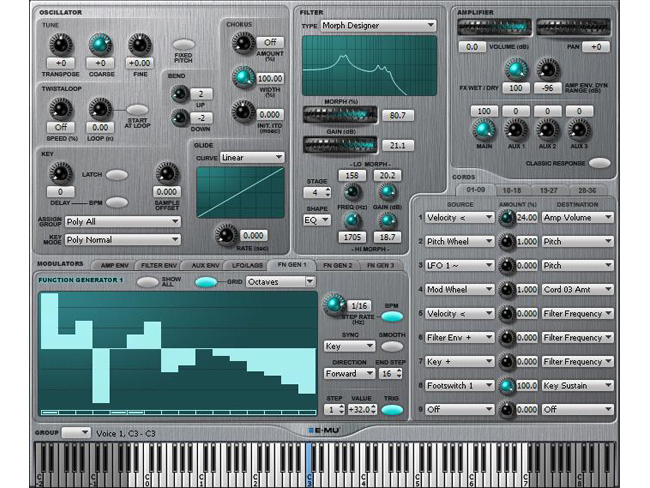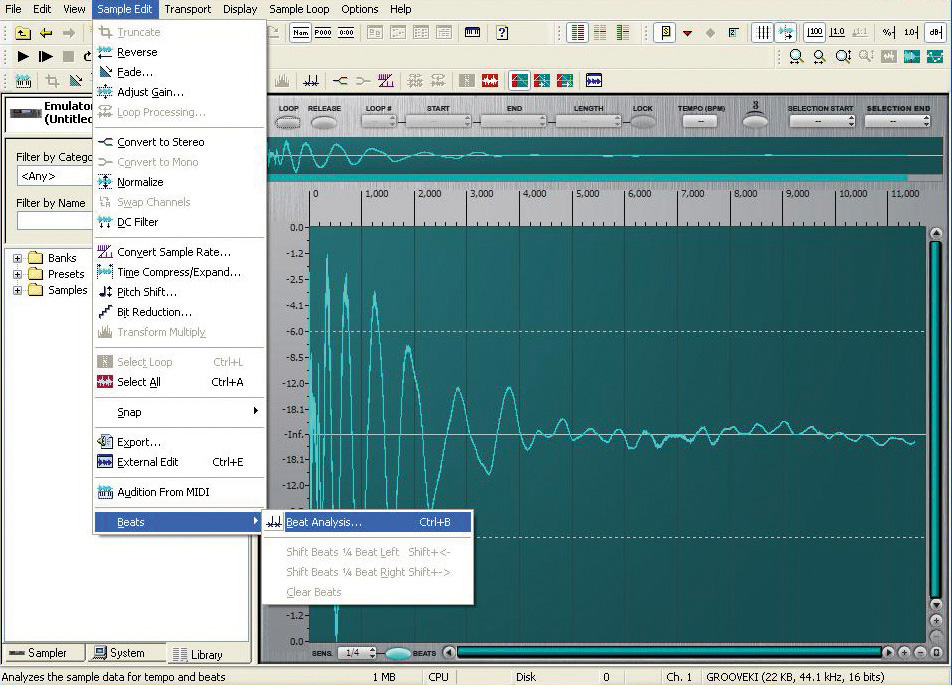MusicRadar Verdict
Works well, looks great and offers some genuinely useful new features.
Pros
- +
Has a refreshing hardware feel. SynthSwipe works superbly. Morphing feature is great.
Cons
- -
Library screen could look a little slicker. You might not need the MIDI interface. There’s some stiff competition.
MusicRadar's got your back


When the Emulator X arrived in 2004 it caused something of a stir. There were two reasons for this: first, it came bundled with a jaw-droppingly good audio interface that offered DSP effects processing.
Second, it channelled E-MU´s 20 years of hardware sampling experience into one fabulous sounding, easy-to-use and obscenely powerful soft sampler. Two years on, its successor has been unleashed. This no longer comes with an audio interface - instead, the full version ships with a 2-In/2-Out MIDI interface that also acts as a dongle. If you don´t want to use this, you´ll need to have another compatible piece of E-MU hardware installed (if you don´t already own such a piece of hardware, your best bet is to buy the Emulator X2 Add-on).
So is this a worthy update or just a cynical spit and polish job? Let´s begin by looking at Emulator X2´s main features (which are fundamentally the same as those of its predecessor).
Interface
The main screen is based around an emulation of a hardware sampler´s front panel and provides access to most of the major controls. These include 16 user-definable MIDI controller knobs and effects assignments. To the left of this section (in both standalone and VST modes) is a familiar Windows-style tree library that enables you to locate and manage all the presets and banks that are stored on your system (like its predecessor, Emulator X2 automatically scans your computer for all compatible files and adds them to your library). To load a preset, you simply drag and drop it into the ‘display´ of the sampler GUI. This works well enough, but the tree interface itself is starting to look a little bit dated.
Feature-wise, E-MU´s DSP architecture means that owners of any compatible E-MU audio interface can use its effects without additional CPU load (in fact, with some clever ASIO routing, you can use these effects within your sequencer too, although they can only be edited from within E-MU´s own PatchMix software interface). And, of course, there´s also the E-MU sampling range´s greatest asset: the Z-Plane filters. These might not feel quite as cutting edge as they did when they were first unleashed in the mid-90s, but they still sound phenomenal. And when deployed in conjunction with the powerful and straightforward envelope, modulation and controller matrices that have made E-MU hardware so popular, they can really make your samples sing. Speaking of samples, you can import a bewildering range of current and older formats.
Tricks
Want all the hottest music and gear news, reviews, deals, features and more, direct to your inbox? Sign up here.
It´s fair to say that Emulator X2 gives you everything you´d expect of a sampler - hard or soft - and does it in a uniquely ‘E-MU´ way. But that´s been the case since the first version, so what´s new?
Our favourite new feature is SynthSwipe. This enables you to automatically multisample a VST or MIDI-compatible hardware instrument and turn it into a fully mapped and velocity-layered patch. Emulator X was always capable of analysing an audio file, chopping it into bits, detecting the pitch and creating a multisampled patch for you - and it always did it very well - but SynthSwipe is far better. Simply set the source, the key range and the velocity settings you want for each key, and this obliging and powerful tool will ‘play´ all the notes on your instrument, record them, edit them, and map them to a given velocity layer of the corresponding note. It works like a dream.
Our next favourite new feature is just the kind of old-school trick we´d expect from E-MU. It´s called Transform Multiply and it takes two sound sources (such as strings and a section of speech), analyses them to find out all the frequencies they have in common, and discards everything else. The resulting fusion is the Brundle-Fly of the audio world, with results both as
grotesque and awe-inspiring as Jeff Goldblum´s wall-climbing alter-ego. It can be a little hit or miss at first, but once you get the knack of using it, Transform Multiply is a sound designer´s dream. There are a number of other handy new features, of course (see So what else is new?), but these two are worth the price of admission alone.
So, Emulator X2 is a worthy upgrade, and definitely worth paying £60 for if you´re an existing user. Given that the original was so good, it was always going to be hard to improve things much, but thanks to a few tweaks and the addition of some killer new features, E-MU have done just that.
Downsides
Our only real complaints concern the ugly library system and, at a push, the fact that you might be paying for a MIDI interface that you don´t need. It could also be argued that in terms of raw sampling power, Emulator X still isn´t up there with GigaStudio 3, but the reality is that the two programs are likely to appeal to slightly different kinds of users. There´s also NI´s Kontakt 2 to consider, but our feeling is that Emulator X2 is a slightly more user-friendly product.
If you fancy a little hardware flavour in your software studio and want to enjoy creative sampling the way we used to, Emulator X2 is a fine choice. It comes with a quality 3GB soundbank (which includes the complete Proteus 2000 soundset and a 1.5GB grand piano), and perhaps most importantly, it´s great fun to use.
MusicRadar is the number 1 website for music makers of all kinds, be they guitarists, drummers, keyboard players, djs or producers...
GEAR: We help musicians find the best gear with top-ranking gear round-ups and high- quality, authoritative reviews by a wide team of highly experienced experts.
TIPS: We also provide tuition, from bite-sized tips to advanced work-outs and guidance from recognised musicians and stars.
STARS: We talk to musicians and stars about their creative processes, and the nuts and bolts of their gear and technique. We give fans an insight into the actual craft of music making that no other music website can.
